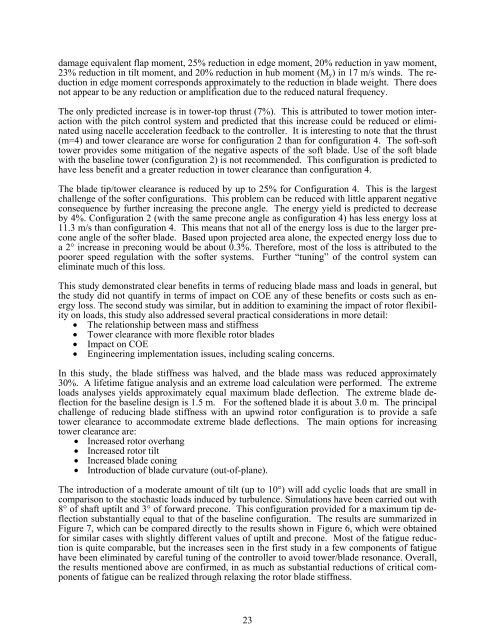Advanced Wind Turbine Program Next Generation Turbine ... - NREL
Advanced Wind Turbine Program Next Generation Turbine ... - NREL
Advanced Wind Turbine Program Next Generation Turbine ... - NREL
Create successful ePaper yourself
Turn your PDF publications into a flip-book with our unique Google optimized e-Paper software.
damage equivalent flap moment, 25% reduction in edge moment, 20% reduction in yaw moment,<br />
23% reduction in tilt moment, and 20% reduction in hub moment (My) in 17 m/s winds. The reduction<br />
in edge moment corresponds approximately to the reduction in blade weight. There does<br />
not appear to be any reduction or amplification due to the reduced natural frequency.<br />
The only predicted increase is in tower-top thrust (7%). This is attributed to tower motion interaction<br />
with the pitch control system and predicted that this increase could be reduced or eliminated<br />
using nacelle acceleration feedback to the controller. It is interesting to note that the thrust<br />
(m=4) and tower clearance are worse for configuration 2 than for configuration 4. The soft-soft<br />
tower provides some mitigation of the negative aspects of the soft blade. Use of the soft blade<br />
with the baseline tower (configuration 2) is not recommended. This configuration is predicted to<br />
have less benefit and a greater reduction in tower clearance than configuration 4.<br />
The blade tip/tower clearance is reduced by up to 25% for Configuration 4. This is the largest<br />
challenge of the softer configurations. This problem can be reduced with little apparent negative<br />
consequence by further increasing the precone angle. The energy yield is predicted to decrease<br />
by 4%. Configuration 2 (with the same precone angle as configuration 4) has less energy loss at<br />
11.3 m/s than configuration 4. This means that not all of the energy loss is due to the larger precone<br />
angle of the softer blade. Based upon projected area alone, the expected energy loss due to<br />
a 2° increase in preconing would be about 0.3%. Therefore, most of the loss is attributed to the<br />
poorer speed regulation with the softer systems. Further “tuning” of the control system can<br />
eliminate much of this loss.<br />
This study demonstrated clear benefits in terms of reducing blade mass and loads in general, but<br />
the study did not quantify in terms of impact on COE any of these benefits or costs such as energy<br />
loss. The second study was similar, but in addition to examining the impact of rotor flexibility<br />
on loads, this study also addressed several practical considerations in more detail:<br />
• The relationship between mass and stiffness<br />
• Tower clearance with more flexible rotor blades<br />
• Impact on COE<br />
• Engineering implementation issues, including scaling concerns.<br />
In this study, the blade stiffness was halved, and the blade mass was reduced approximately<br />
30%. A lifetime fatigue analysis and an extreme load calculation were performed. The extreme<br />
loads analyses yields approximately equal maximum blade deflection. The extreme blade deflection<br />
for the baseline design is 1.5 m. For the softened blade it is about 3.0 m. The principal<br />
challenge of reducing blade stiffness with an upwind rotor configuration is to provide a safe<br />
tower clearance to accommodate extreme blade deflections. The main options for increasing<br />
tower clearance are:<br />
• Increased rotor overhang<br />
• Increased rotor tilt<br />
• Increased blade coning<br />
• Introduction of blade curvature (out-of-plane).<br />
The introduction of a moderate amount of tilt (up to 10°) will add cyclic loads that are small in<br />
comparison to the stochastic loads induced by turbulence. Simulations have been carried out with<br />
8° of shaft uptilt and 3° of forward precone. This configuration provided for a maximum tip deflection<br />
substantially equal to that of the baseline configuration. The results are summarized in<br />
Figure 7, which can be compared directly to the results shown in Figure 6, which were obtained<br />
for similar cases with slightly different values of uptilt and precone. Most of the fatigue reduction<br />
is quite comparable, but the increases seen in the first study in a few components of fatigue<br />
have been eliminated by careful tuning of the controller to avoid tower/blade resonance. Overall,<br />
the results mentioned above are confirmed, in as much as substantial reductions of critical components<br />
of fatigue can be realized through relaxing the rotor blade stiffness.<br />
23
















